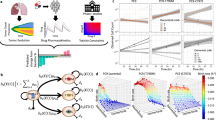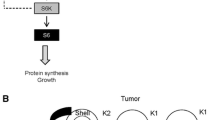Abstract
We report on a retrospective model-based assessment of the predictive value of translating antitumor drug activity from in vivo experiments to a phase I clinical study in cancer patients treated with the MDM2 inhibitor, HDM201. Tumor growth inhibition models were developed describing the longitudinal tumor size data in human-derived osteosarcoma xenograft rats and in 96 solid tumor patients under different HDM201 treatment schedules. The model structure describing both datasets captures the delayed drug effect on tumor growth via a series of signal transduction compartments, including a resistance component. The models assumed a drug-killing effect on both sensitive and resistant cells and parameterized to estimate two tumor static plasma drug concentrations for sensitive (TSCS) and resistant cells (TSCR). No change of TSCS and TSCR with schedule was observed, implying that antitumor activity for HDM201 is independent of treatment schedule. Preclinical and clinical model-derived TSCR were comparable (48 ng/mL vs. 74 ng/mL) and demonstrating TSCR as a translatable metric for antitumor activity in clinic. Schedule independency was further substantiated from modeling of clinical serum growth differentiation factor-15 (GDF-15) as a downstream marker of p53 pathway activation. Equivalent cumulative induction of GDF-15 was achieved across schedules when normalized to an equivalent total dose. These findings allow for evaluation of optimal dosing schedules by maximizing the total dose per treatment cycle while mitigating safety risk with periods of drug holiday. This approach helped guide a phase I dose escalation study in the selection of an optimal dose and schedule for HDM201.








Similar content being viewed by others
References
Shi D, Gu W. Dual roles of MDM2 in the regulation of p53: ubiquitination dependent and ubiquitination independent mechanisms of MDM2 repression of p53 activity. Genes Cancer. 2012;3(3-4):240–8.
Moll UM, Petrenko O. The MDM2-p53 interaction. Mol Cancer Res. 2003;1(14):1001–8.
Vassilev LT, Vu BT, Graves B, Carvajal D, Podlaski F, Filipovic Z, et al. In vivo activation of the p53 pathway by small-molecule antagonists of MDM2. Science. 2004;303(5659):844–8.
Siu LL, Italiano A, Miller WH, et al. Phase 1 dose escalation, food effect, and biomarker study of RG7388, a more potent second-generation MDM2 antagonist, in patients with solid tumors. J Clin Oncol. 2014;32(15_suppl):2535.
Ohnstad HO, Castro R, Sun J, Heintz KM, Vassilev LT, Bjerkehagen B, et al. Correlation of TP53 and MDM2 genotypes with response to therapy in sarcoma. Cancer. 2013;119(5):1013–22.
Canon J, Osgood T, Olson SH, Saiki AY, Robertson R, Yu D, et al. The MDM2 inhibitor AMG232 demonstrates robust antitumor efficacy and potentiates the activity of p53-inducing cytotoxic agents. Mol Cancer Ther. 2015;14(3):649–58.
Gluck WL, Gounder MM, Frank R, Eskens F, Blay JY, Cassier PA, et al. Phase 1 study of the MDM2 inhibitor AMG232 in patients with advanced P53 wild-type solid tumors or multiple myeloma. Investig New Drugs. 2020;38:831–43.
Abdul Razak AR, Miller WH Jr, Uy GL, Blotner S, Young AM, Higgins B, et al. A phase 1 study of the MDM2 antagonist RO6839921, a pegylated prodrug of idasanutlin, in patients with advanced solid tumors. Investig New Drugs. 2020;38:1156–65.
Wagner AJ, Banerji U, Mahipal A, Somaiah N, Hirsch H, Fancourt C, et al. Phase I trial of the human double minute 2 inhibitor MK-8242 in patients with advanced solid tumors. J Clin Oncol. 2017;35(12):1304–11.
Holzer P. Discovery of potent and selective p53-MDM2 protein–protein interaction inhibitors as anticancer drugs. Chimia. 2017;71:716–21.
Hyman DM, Chatterjee M, de Vos F, Lin C-C, Suárez C, Tai D, et al. Optimizing the therapeutic index of HDM2 inhibition: results from a dose- and regimen finding phase I study of NVP-HDM201 in pts with TP53 wt advanced tumors. Cancer Res. 2017;77(13):supplement 1.
Higgins B, Glenn K, Walz A, Tovar C, Filipovic Z, Hussain S, et al. Preclinical optimization of MDM2 antagonist scheduling for cancer treatment by using a model-based approach. Clin Cancer Res. 2014;20(14):3742–52.
Meille C, Reddy MB, Walz A, Retout S, Nichols G, Glenn K, et al. Modified model of drug induced thrombocytopenia efficiently projects safe starting dose in human from preclinical data. In: Poster presentation, PAGE meeting; 2012, http://www.page-meeting.org/?abstract=2446. Accessed 30 Aug 2020
Lindauer A, Valiathan CR, Mehta K, Sriram V, de Greef R, Elassaiss-Schaap J, et al. Translational pharmacokinetic / pharmacodynamic modeling of tumor growth inhibition supports dose-range selection of the anti-PD-1 antibody pembrolizumab. CPT Pharmacometrics Syst Pharmacol. 2017;6:11–20.
Bender BC, Schindler E, Friberg LE. Population pharmacokinetic-pharmacodynamic modelling in oncology: a tool for predicting clinical response. Br J Clin Pharmacol. 2015;79(1):56–71.
Ait-Oudhia S, Mager DE. Array of translational systems pharmacodynamic models of anti-cancer drugs. J Pharmacokinet Pharmacodyn. 2016;43(6):549–65.
Mould DR, Walz AC, Lave T, Gibbs JP, Frame B. Developing exposure/response models for anticancer drug treatment: special considerations. CPT Pharmacometrics Syst Pharmacol. 2015;4:12–27.
Hartung N, Mollard S, Barbolosi D, Benabdallah A, Chapuisat G, Henry G, et al. Mathematical modeling of tumor growth and metastatic spreading: validation in tumor-bearing mice. Cancer Res. 2014;74(22):6397–407.
Eigenmann MJ, Frances N, Hoffmann G, Lave T, Walz AC. Combining nonclinical experiments with translational PKPD modeling to differentiate erlotinib and gefitinib. Mol Cancer Ther. 2016;15(12):3110–9.
Wong H, Choo EF, Alicke B, Ding X, La H, McNamara E, et al. Antitumor activity of targeted and cytotoxic agents in murine subcutaneous tumor models correlates with clinical response. Clin Cancer Res. 2012;18(14):3846–55.
Claret L, Girard P, Hoff PM, Van Cutsem E, Zuideveld KP, Jorga K, et al. Model-based prediction of phase III overall survival in colorectal cancer on the basis of phase II tumor dynamics. J Clin Oncol. 2009;27(25):4103–8.
Chatterjee M, Elassaiss-Schaap J, Lindauer A, Turner D, Sostelly A, Freshwater T, et al. Population pharmacokinetic/pharmacodynamic modeling of tumor size dynamics in pembrolizumab-treated advanced melanoma. CPT Pharmacometrics Syst Pharmacol. 2017;6:29–39.
Jeay S, Ferretti S, Holzer P, Fuchs J, Chapeau EA, Wartmann M, et al. Dose and schedule determine distinct molecular mechanisms underlying the efficacy of the p53-MDM2 inhibitor HDM201. Cancer Res. 2018;78(21):6257–67.
Lindstrom ML, Bates DM. Nonlinear mixed effects models for repeated measures data. Biometrics. 1990;46:673–87.
Sheiner LB, Ludden TM. Population pharmacokinetics/dynamics. Annu Rev Pharmacol Toxicol. 1992;32:185–209.
Deylon B, Lavielle M, Moulines E. Convergence of a stochastic approximation version of the EM algorithm. Ann Stat. 1999;27(1):94–128.
Simeoni M, Magni P, Cammia C. Predictive Pharmacokinetic-pharmacodynamic modeling of tumor growth kinetics in xenograft models after administration of anticancer agents. Cancer Res. 2004;64(3):1094–101.
Murphy H, Jaafari H, Dobrovolny HM. Differences in predictions of ODE models of tumor growth: a cautionary example. BMC Cancer. 2016;16:163.
Ribba B, Holford NH, Magni P, Trocóniz I, Gueorguieva I, Girard P, et al. A review of mixed-effects models of tumor growth and effects of anticancer drug treatment used in population analysis. CPT Pharmacometrics Syst Pharmacol. 2014;3(5):e113.
Lobo ED, Balthasar JP. Pharmacodynamic modeling of chemotherapeutic effects: application of a transit compartment model to characterize methotrexate effects in vitro. AAPS Pharm Sci. 2002;4(4):E42.
Benzekry S, Lamont C, Beheshti A, Tracz A, Ebos JML, Hlatky L, et al. Classical mathematical models for description and prediction of experimental tumor growth. PLoS Comput Biol. 2014;10(8):e1003800.
Vaghi C, Rodallec A, Fanciullino R, Ciccolini J, Mochel JP, Mastri M, et al. Population modeling of tumor growth curves and the reduced Gompertz model improve prediction of the age of experimental tumors. PLoS Comput Biol. 2020;16(2):e1007178.
Norton L, Simon R. Growth curve of an experimental solid tumor following radiotherapy. J Natl Cancer Inst. 1977;58(6):1735–41.
Vasan N, Baselga J, Hyman DM. A view on drug resistance in cancer. Nature. 2019;575:299–309.
Amarnath S, Jusko WJ. Characteristics of indirect pharmacodynamic models and applications to clinical drug responses. Br J Clin Pharmacol. 1998;45:229–39.
Yang H, Filipovic Z, Brown D, Breit SN, Vassilev LT. Macrophage inhibitory cytokine-1: a novel biomarker for p53 pathway activation. Mol Cancer Ther. 2003;2:1023–9.
Andreeff M, Kelly KR, Yee K, Assouline S, Strair R, Popplewell L, et al. Results of the phase I trial of RG7112, a small-molecule MDM2 antagonist in leukemia. Clin Cancer Res. 2016;22:868–76.
Meille C, Guerreiro N, Jullion A, Bauer S, Chatterjee M, de Vos F, et al. Optimization of the dose and schedule of an HDM2 inhibitor NVP-HDM201 in a first-in-human phase I study using a mechanism-based PK/PD model [abstract]. In: Proceedings of the American Association for Cancer Research Annual Meeting; 2017 Apr 1-5; Washington, DC. Philadelphia; Cancer Res. 2017;77(13 Suppl).
Meille C, Guerreiro N, Fabre C, Jullion A. Dosing Regimen selection supported by population PKPD model of thrombocytopenia [abstract]. In: Proceedings of the annual meeting of the Population Approach Group in Europe; 2017 May 29-Jun 1; Montreux, Switzerland. Available from: www.page-meeting.org/?abstract=8612. Accessed 30 Aug 2020
Lestini G, Mentré F, Magni P. Optimal design for informative protocols in xenograft tumor growth inhibition experiments in mice. AAPS J. 2016;18(5):1233–43.
Acknowledgments
We acknowledge and thank the patients and their families, the study investigators, coordinators, site personnel, and the clinical sites. The authors would like to thank Luisa Mariconti and Matthieu Klopfenstein for their support in clinical data curation and methodology guidance. Peter Lu is thanked for programming assistance and for generating the clinical dataset.
Funding
This study was funded by the Novartis Pharmaceuticals Corporation.
Author information
Authors and Affiliations
Corresponding author
Ethics declarations
Conflict of Interest
All authors are or were employees of Novartis at the time of the research.
Additional information
Publisher’s Note
Springer Nature remains neutral with regard to jurisdictional claims in published maps and institutional affiliations.
Supplementary Information
ESM 1
(DOCX 676 kb)
Rights and permissions
About this article
Cite this article
Guerreiro, N., Jullion, A., Ferretti, S. et al. Translational Modeling of Anticancer Efficacy to Predict Clinical Outcomes in a First-in-Human Phase 1 Study of MDM2 Inhibitor HDM201. AAPS J 23, 28 (2021). https://doi.org/10.1208/s12248-020-00551-z
Received:
Accepted:
Published:
DOI: https://doi.org/10.1208/s12248-020-00551-z




